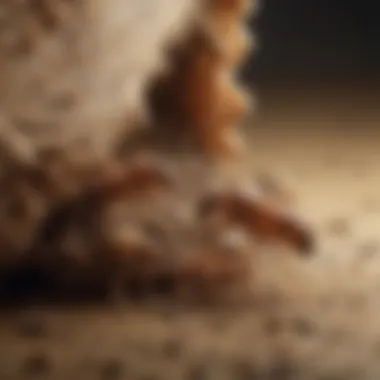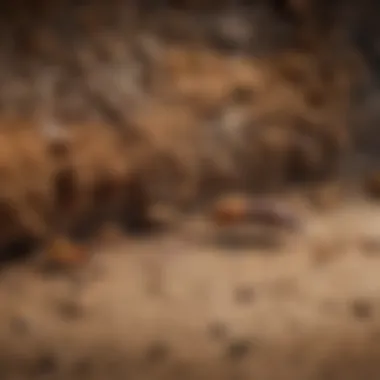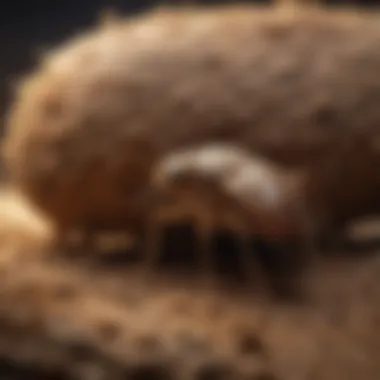Understanding Termite Survival in Winter Conditions


Intro
Termites are often overlooked when discussing home pests, but their presence can lead to significant damage, especially during colder months. Understanding how these insects survive winter conditions is essential for effective pest management. This article examines the biological traits and adaptations of termites that allow them to endure low temperatures. Moreover, it also highlights the role of environmental factors in their survival and offers practical insights for homeowners. By utilizing this knowledge, individuals can take proactive measures to prevent infestations and protect their properties year-round.
Pest Identification
To manage termite infestations, it is crucial to clearly identify the type of pests involved. Termites typically belong to two major categories: drywood and subterranean. Both types exhibit distinct behaviors and habitats.
- Drywood Termites
- Subterranean Termites
- These termites live within the wood they consume and do not require contact with soil.
- They are often found in wooden structures, furniture, and other cellulose-based materials.
- These termites build colonies underground and usually prefer moist soil, but they also travel to wood sources above ground.
- They create mud tubes to protect themselves while foraging for food.
Signs and Symptoms of Infestations
Recognizing the signs of a termite infestation early can mitigate damage. Look for:
- Mud Tubes: Small, pencil-sized tunnels leading from the ground to a structure.
- Wood Damage: Hollowed out wood or visible exit holes.
- Frass: Small droppings that resemble sawdust, indicating active feeding.
"Timely detection of termites is key to reducing potential damage to your property."
Prevention Strategies
Preventing termite infestations requires consistent effort and strategic home maintenance. Homeowners can implement various strategies to reduce the risk.
Home Maintenance Tips for Pest Prevention
- Reduce Moisture: Ensure proper drainage around the home, and fix leaky faucets or overflowing gutters.
- Seal Cracks: Inspect and seal any cracks in foundations or walls to eliminate access points.
- Wood Treatment: Treat wooden structures with protective coatings to discourage termite activity.
Natural Deterrents and Barriers
Using natural deterrents can be effective in maintaining an insect-free environment. Some homeowners find success with:
- Boric Acid: This natural compound can be applied to wood to deter termite feeding.
- Nematodes: Beneficial nematodes can be introduced into the soil, targeting termite larvae.
Treatment Options
If an infestation occurs, choosing the right treatment is crucial. Homeowners often face the choice between chemical and natural methods.
Overview of Chemical vs. Natural Treatments
- Chemical Treatments: Such as fipronil or imidacloprid, are effective but require careful handling and application.
- Natural Treatments: Some prefer to utilize solutions like orange oil or vinegar as less toxic alternatives.
Step-by-Step Guides for DIY Treatments
For those inclined to handle the treatment themselves, follow these basic steps:
- Identify the infested area and assess the extent of the damage.
- Choose your treatment method, whether chemical or natural.
- Apply the solution according to product directions.
- Monitor the area regularly for signs of continued infestation.
Understanding termite survival in winter is paramount for homeowners seeking to protect their properties. Through careful identification, preventative measures, and effective treatments, one can manage these pests throughout the year.
Prologue to Termite Biology
Understanding termite biology is crucial to comprehend their behavior during different seasons, particularly winter. This knowledge not only aids homeowners in recognizing potential infestation risks but also sheds light on the ecological role termites play. By grasping the basics of their biology, one can appreciate the complexities of their survival strategies, especially when faced with harsh environmental conditions. Furthermore, it's important to consider how these biological factors intertwine with practical pest management strategies.


Overview of Termite Species
Termites belong to the insect order Isoptera, which consists of various species that vary significantly in their habitat preferences and feeding behaviors. Generally, there are three main types of termites: subterranean, drywood, and dampwood. Subterranean termites, such as the Eastern subterranean termite, often build extensive underground colonies. They thrive in moist soils and can cause significant damage to wooden structures.
Drywood termites, on the other hand, live within the wood they consume, preferring dry environments, which makes them a major concern for homeowners in arid regions. They do not require contact with soil and can infest furniture or wooden features of a home. Then, there are dampwood termites, which prefer decaying wood with high moisture content. Each of these species has distinct survival mechanisms that influence their behavior in winter conditions.
Role of Temperature in Termite Behavior
Temperature is a critical factor influencing termite activity. Termites are ectothermic, meaning their internal body temperature reflects the environmental temperature. As winter approaches, temperatures drop significantly, which directly affects their metabolism and behavior. In colder conditions, termites may enter a state of dormancy. However, they do not die; rather, their activity slows down substantially.
During this period, termites seek refuge in deeper soil where temperatures are more stable and warmer. They also cluster together in order to maintain heat. This strategy is vital for their survival as it allows them to conserve energy while still being protected from extreme cold. Understanding these temperature dynamics can help homeowners identify when termites might be active and how they can protect their homes during winter months.
Seasonal Changes and Termite Activity
Understanding the seasonal changes that impact termite activity is crucial for homeowners and pest control specialists alike. The behavior of termites varies significantly with the seasons, which directly affects their survival strategies during winter. This knowledge helps in preparing effective pest control measures and maintaining the integrity of structures susceptible to termite damage. Recognizing how seasonal shifts influence termite behavior can improve the timing and methods of intervention.
How Different Seasons Affect Termite Behavior
Termites are ectothermic organisms, meaning their body temperature is influenced by the surrounding environment. In warmer months, they are most active. This is when they forage for food and expand their colonies. During spring and summer, termites can be seen swarming and establishing new colonies, taking advantage of the abundant resources available.
As temperatures drop in fall, termites begin to prepare for the winter months. Subterranean termites often retreat deeper into the soil, seeking insulation from the cold. Their metabolic rates decrease, enabling them to survive on stored energy. Drywood termites, however, do not exhibit as strong a seasonal cycle as subterranean species. They reside within the wood they infest, managing to remain relatively insulated from external temperatures.
Winter brings about a drastic change. When the ground freezes, termites are pushed even deeper into the soil, where temperatures remain more stable. They continue to survive but at a much slower pace, reflecting a significant reduction in their activity levels. Understanding these patterns allows for better monitoring and potential species identification through distinct seasonal behaviors.
Temperature Thresholds for Termite Survival
Termites have specific temperature thresholds that dictate their ability to thrive. Typically, they prefer temperatures between 75 to 95 degrees Fahrenheit. When temperatures dip below 50 degrees, most termite activity ceases. At extremes, especially below freezing, termites can be put at risk.
While cold temperatures can kill termites, it is not guaranteed. For instance, subterranean termites can survive prolonged cold by burrowing deep into the ground where temperatures are milder, whereas drywood termites may struggle since they rely heavily on the wood they infest, which does not insulate them effectively from the cold.
It is also important to note that temperature fluctuations can have consequences. If a warm spell occurs in the middle of winter, termites may become temporarily active, which can lead to increased foraging and potential damage to homes if they are not properly managed.
Understanding the temperature thresholds of termites aids homeowners in detecting the risks during winter months, allowing for timely interventions.
Do Termites Die in Winter?
The question of whether termites die in winter is crucial to understanding their behavior and survival strategies. It also impacts the way homeowners approach pest management. Many people believe that colder temperatures are lethal for termites. This belief leads to a false sense of security during the winter months. Termites are not as vulnerable to low temperatures as commonly thought, and this misconception can have serious implications for homes.
Understanding the biology of termites reveals their remarkable adaptations to harsh environments. These adaptations allow them to survive winter conditions that seem fatal to many other insects. Knowledge of these behaviors helps homeowners identify potential infestations and apply appropriate pest control measures effectively, ensuring their homes stay termite-free all year long.
The Myth of Winter Termite Deaths
The myth that termites perish in the winter often stems from observable behaviors in colder climates. While it is true that termite activity decreases significantly in lower temperatures, it does not necessarily mean they die. Subterranean termites, for example, can retreat deep underground where temperatures are more stable and milder. They are insulated from extreme winter conditions by soil, which maintains a higher temperature.
Key points about winter termite deaths:
- Survival Instincts: Termites have evolved to survive cold by reducing their metabolic rates. This adjustment helps them withstand periods of low activity without a significant loss of life.
- Moist Environments: In nature, moisture plays a role in their survival. Termites often seek damp areas, which helps them retain the necessary moisture to live, even in winter.
- Subterranean Habitats: Nesting in the ground shields termites from the cold. This strategic choice is critical for survival in regions with freezing temperatures.
Despite these facts, many assume that winter eliminates termite threats. This logical fallacy can lead to negligence in property inspections and pest control strategies during winter months.
Adaptations That Aid Survival During Cold Months
Termites possess various adaptations that enable them to survive through the winter. These adaptations are fascinating and demonstrate the insects' resilience.
Key adaptations include:
- Nesting Structures: Subterranean termites build their colonies below the frost line in the soil. These nests serve as a protected environment that safeguards them from extreme temperatures.
- Social Behavior: Termites are social insects, living in colonies that provide warmth through collective body heat. The larger the colony, the more it can retain warmth during cold spells.
- Moisture Management: The organisms are adept at managing moisture levels within their nests. They create mud tubes, which help them access food sources while regulating humidity levels within their underground homes.
- Metabolic Rate Adjustment: When temperatures drop, termites lower their metabolism, which conserves energy. This allows them to survive on fewer resources until warmer weather returns.


Understanding these adaptations is crucial for pest control strategies. Homeowners must recognize that termites can still wreak havoc in winter. Termite control measures should not be dismissed simply because temperatures have dropped.
Types of Termites and Their Winter Behaviors
Understanding the various types of termites and their distinct winter behaviors is critical for comprehending how these pests manage to survive colder months. Not all termites react the same way to winter conditions, and awareness of these differences can significantly inform pest management strategies. Different species exhibit unique adaptations and behaviors that allow them to endure low temperatures. Thus, knowing which type is present in your region can help homeowners implement effective prevention measures and control efforts during winter months.
Subterranean Termites
Subterranean termites are perhaps the most notorious among termite species, frequently causing significant damage to wooden structures. These termites live beneath the soil, forming colonies that can number in the hundreds of thousands. Their strategy for winter survival involves burrowing deep into the ground where temperatures are relatively stable and warmer compared to surface conditions. As temperatures drop, subterranean termites retreat deeper into their tunnels, often reaching depths below 20 inches, where they remain insulated from the cold.
This ability to migrate underground allows subterranean termites to access moisture and warmth, both vital for their survival. They build mud tubes to travel between food sources and their nests without exposure to open air, which is crucial during winter when they are more vulnerable. Homeowners need to be vigilant for signs of these mud tubes and take early preventive action.
Drywood Termites
In contrast to subterranean species, drywood termites inhabit dry wood and do not require contact with soil. They typically infest wooden structures, furniture, and trees. Unlike their subterranean counterparts, drywood termites can endure more extreme temperature variations but still have specific winter behaviors. During colder months, these termites generally reduce their activity. They remain in their wood galleries, where they obtain moisture from the wood itself.
Drywood termites have adapted to withstand relatively low temperatures, but prolonged exposure can still be detrimental. If indoor environments drop significantly in temperature, these termites may halt their feeding and reproduction, ultimately leading to detrimental effects on the colony.
It's important for homeowners to recognize that signs of drywood termite activity may not be as apparent during winter months as these pests are less mobile. Regular inspections during winter can help identify potential infestations before they become a larger issue.
Important Note: Both subterranean and drywood termites can survive winter, but their approaches vary. Homeowners should adopt tailored approaches for each type to effectively manage risk.
Finale
Understanding the behaviors of subterranean and drywood termites during winter is essential for effective pest management. By recognizing their unique survival strategies, homeowners can adopt informed preventive measures, ensuring structural integrity and reducing the risk of extensive damage. This knowledge aids in timely inspections and interventions, contributing to a comprehensive pest control strategy throughout the year.
Environmental Factors Influencing Winter Survival
Understanding the environmental factors influencing termite survival in winter conditions is crucial for proper pest management. These factors impact not only how termites behave during colder months but also provide insight into how homeowners can protect their properties. Key environmental elements include soil temperature dynamics and moisture retention, both of which play significant roles in determining termite activity and survival.
Improper management of these factors can lead to increased chances of infestation. Therefore, remaining aware of how soil temperature and moisture levels change seasonally can enable homeowners to adopt preventive measures. This article section will elucidate these environmental aspects in detail, emphasizing both their effects on termites and practical steps for homeowners.
Soil Temperature Dynamics
Soil temperature is one of the most critical environmental factors affecting termite behavior and survival. Termites, particularly subterranean species, rely on the warmth of the soil to maintain their activity levels. When temperatures drop, their metabolic rate slows, leading to reduced foraging and feeding often resulting in lower levels of activity.
Soil temperatures can vary based on several factors:
- Depth of the Soil: Generally, the deeper the soil, the more stable and warmer the temperature remains. Termites tend to burrow into deeper sections of soil to escape the cold, which can mean a substantial amount of heat retention.
- Latent Heat: During winter, moisture can freeze the surface layer of soil while deeper layers might remain unfrozen due to the insulation properties of the soil and biological activities from other organisms.
Understanding the dynamics of soil temperature can help in predicting termite activity. Homeowners can monitor the temperature changes in their yards during winter to identify potential areas of concern where termites may continue to survive.
Moisture Retention and Termite Habitats
Moisture is another key factor influencing termite habitation and survival during winter months. Termites require a moist environment to survive, as their bodies can easily dry out. Moisture retention in the soil provides the ideal conditions for termites to thrive.
Several aspects contribute to moisture dynamics:
- Soil Composition: Different types of soil retain moisture differently. Clay soils, for example, tend to hold more water compared to sandy soils, creating a more favorable habitat for termites.
- Landscape Features: Areas with more vegetation can retain moisture better, offering termites an environment to survive despite freezing temperatures.
- Drainage Patterns: Poor drainage around the home can lead to increased humidity and moisture accumulation in certain areas, making those spots more attractive to termites.
Homeowners should consider reducing moisture retention in and around their homes. Potential strategies include maintaining good drainage, ensuring gutters function correctly, and avoiding excessive landscaping near foundations.
Understanding the impact of moisture on termite survival can offer essential guidance for prevention and control measures during the winter.
"Knowledge of environmental factors is key to effective termite management. By monitoring soil temperature and moisture, homeowners can protect their properties more effectively.”
Through awareness and proactive strategies, homeowners can significantly reduce the risk of winter infestations and ensure the long-term integrity of their homes.


Implications for Homeowners and Pest Management
The survival of termites during winter months has significant implications for homeowners and pest management. Understanding how these pests adapt to cold weather can inform better strategies for prevention and control. It is crucial for homeowners to recognize that many believe termites die off in winter. This is a misconception that could lead to neglect during colder months.
Key elements to consider include:
- Preparation: Preparing for termite activity in winter is essential. By employing preventive measures before the temperatures drop, homeowners can insulate their homes against potential invasions.
- Behavioral Understanding: Knowing that termites adapt their behaviors allows homeowners to identify risks. For example, subterranean termites may move deeper into the ground to escape severe cold, but their presence doesn’t vanish altogether.
- Year-Round Monitoring: Termite management should be continuous. Signs of termite activity can be subtle during winter but can lead to severe damage if left unchecked.
- Pest Control Advancements: Recent developments in pest management, such as the use of baiting systems and eco-friendly treatments, improve the chances of keeping these pests at bay effectively.
"Regular winter inspections and informed preventive actions can save homeowners from costly repairs due to termite damage."
Understanding these implications allows for more effective pest management practices that ensure the security of one’s home throughout the seasons.
Winter Preparation for Pest Control
Winter preparation for pest control is a proactive approach. Homeowners should take specific steps to minimize the risks of termite infestations.
- Inspections: Schedule professional inspections before winter. Experts can assess potential entry points and infested areas.
- Moisture Control: Ensure that gutters are clean and functioning. Water sources attract termites. Make sure there are no leaks in the roofing or plumbing systems.
- Wood Treatments: Apply borate treatments to wooden structures and foundations. This provides a chemical barrier against termites.
- Seal Cracks: Check for cracks in the foundation and seal them. This includes window frames and doorways.
Preparation efforts should not only focus on prevention but also on strengthening the home’s defenses against these pests.
Signs of Termite Activity During Winter
Identifying signs of termite activity during winter can be challenging. However, certain indicators can provide clues. Homeowners should be vigilant in observing these signs:
- Mud Tubes: Look for small mud tubes made by subterranean termites on exterior walls or foundations. These help termites travel between their colonies and wood sources.
- Droppings: Termite droppings, often referred to as frass, can be found near wood fixtures. This waste is often granular and resembles sawdust.
- Swarmers: Winged termites may occasionally emerge. This usually indicates a colony is nearby.
- Hollow Sounding Wood: Knock on wooden surfaces; if they sound hollow, it may indicate internal damage.
Recognizing these signs early can lead to timely interventions, preventing more severe issues down the line.
Preventive Measures Against Winter Infestations
The threat of termite infestations does not vanish with the arrival of colder months. In fact, winter can be a critical time for homeowners to implement preventive measures. Understanding the behaviors of termites during these conditions can help in safeguarding homes from potential damage. The focus here must be on preparing and maintaining properties to deter termites from settling in, ensuring that efforts are continuous throughout the year.
Structural Integrity and Maintenance
Maintaining the structural integrity of a home is a fundamental preventive measure against termites. Termites are drawn to wood, particularly when it is damp or decaying. Regular inspection of wooden structures, including foundations, beams, and even furniture, is essential. Homeowners should look for signs of moisture, such as leaks or condensation, which can attract termites.
- Seal Cracks and Gaps: Any openings in walls or foundations should be sealed. Gaps allow termites easy access into the home.
- Improve Drainage: Ensure proper drainage around the house. Water pooling around the foundation makes it more appealing for termites.
- Regular Inspections: Hire a professional pest control service to conduct annual inspections. They can identify potential entry points and areas of vulnerability long before a problem escalates.
- Timber Treatment: Applying treatments to wooden structures can provide an additional barrier against termite attack. Select a treatment that is environmentally safe and effective.
Landscaping Considerations
Landscaping plays a significant role in determining a home's vulnerability to termite infestations. Thoughtful planning and maintenance can minimize risk factors associated with outdoor environments. Here are some critical considerations:
- Distance from Soil: Ensure that wooden structures, such as decks and fences, are not in direct contact with soil. Using concrete or metal supports can help keep these structures elevated and dry.
- Mulch Management: Mulch is often used in landscaping, but it can attract termites, especially if it is made from untreated wood. Using stone-based materials, or treated wood mulch, can help reduce this risk.
- Plant Choice: Opt for plants that are less likely to host termites. Some plants can attract pests; being selective can be a tactical approach.
- Moisture Control: Maintain a dry landscape. This includes ensuring that gutters are clean and functional, directing water away from structures.
"Preventing termite infestations is a proactive approach; it is easier and more cost-effective than dealing with damage after an invasion."
In summary, safeguarding a home against winter termite infestations requires diligence and attention to detail. Addressing structural integrity through maintenance, and being strategic with landscaping, can make a substantial difference in pest management. Emphasizing these areas will reinforce defenses during the cold months, ensuring homes remain protected year-round.
Closure
Summarizing Termite Resilience
Termites adapt to various environmental challenges, including harsh winter conditions. Their survival relies on several key adaptations unique to their species. For instance, subterranean termites construct extensive tunnel systems that regulate temperature and humidity, allowing them to remain protected from colder external conditions. Drywood termites, on the other hand, protect themselves in the wood they infest, relying on their insulation properties.
Additionally, termites can enter a state of dormancy when faced with extreme cold. This reduces their metabolic rate and helps conserve energy. Understanding these behaviors is crucial for homeowners. Recognizing that termites do not die off in cold weather but merely become less active can shape pest control strategies throughout the year.
Final Thoughts on Seasonal Pest Management
Addressing termite issues requires a proactive approach to pest management. By understanding the lifecycle and seasonal behaviors of termites, homeowners can implement better strategies to protect their properties. Seasonal awareness enables effective monitoring of potential infestations, leading to timely interventions.
"A thorough understanding of termite resilience and behavior can significantly impact pest management success."
Ultimately, maintaining an ongoing vigilance towards termite activity will equip homeowners to confront these persistent pests, ensuring their homes remain safe and free from damage.



